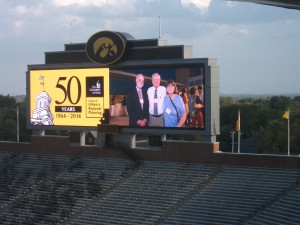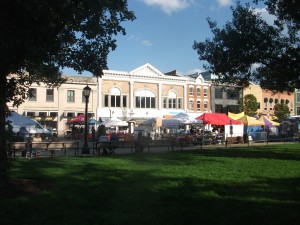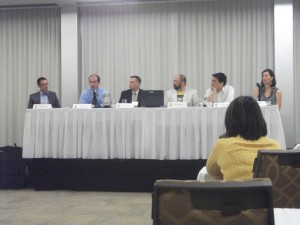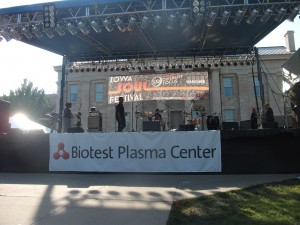College towns can be as different from each other as they are collectively from most other communities. Some literally dominate the economic landscape of their communities. Others are comfortably lodged in a setting that involves a larger community or even a state capital. They have different histories, different strengths, and different outlooks.
What they tend to have in common is a high average level of education and a large number of young people and faculty brimming with new ideas. But they don’t always tap that imagination effectively, sometimes at all, and not all are good at bridging the famous gap between town and gown. So how do they chart an economic future for themselves?

The SURP 50th anniversary dinner took place after the conference at the Kinnick Stadium Press Box. The photographer posted photos from a reception on Friday night at the downtown hotelVetro on the stadium’s Jumbotron. It was not my first appearance on a Jumbotron–that was in Fenway Park in April 2011–but that is another story for another time. With m in this image are Professor John Fuller and my wife, Jean.
On Saturday, September 20, I was in Iowa City listening to, and sometimes asking questions of, a series of panels that comprised an all-day Midwest Creative College Town Conference. The event did not occur in isolation. It was part of the 50th anniversary of the University of Iowa’s School of Urban and Regional Planning, whose creation in 1964 some far-sighted folks back then thought made sense in a largely rural, agrarian state. Over time, Iowa has become considerably more urban: It was noted that the two areas of the state gaining population are the Cedar Rapids/Iowa City corridor and the Des Moines metropolitan area. Almost all others have been losing population steadily for some time. There are reasons for those trends. I attended in a dual capacity, as both an alumnus (Class of 1985) and adjunct faculty. I teach a course each year on “Planning for Disaster Mitigation and Recovery.” Not so coincidentally, this course became part of the school’s curriculum in 2008, following massive floods that severely affected both Cedar Rapids and Iowa City. The school offers a graduate-level curriculum, in which students earn a master’s degree in planning, many of them, however, in combination with degrees in other fields like law or public health. I was the oddball. I earned a second degree in journalism.
SURP Director Charles Connerly organized four panels, three to discuss economic development strategies in college towns, and a final one to discuss the role of the arts in Iowa City. Of the three, I found the panels from Iowa City and East Lansing, Michigan, to have very substantive thoughts on the subject, but was more disappointed with the panel from Lincoln, Nebraska. I will offer more on that later.
But note the differences. Iowa City, once the territorial capital of Iowa prior to statehood, lost that distinction after statehood to Des Moines, but the capitol building became the core of a state university. Old Capitol remains open as a museum that one can visit, the heart of the Pentacrest, a complex of buildings immediately adjacent to the downtown. As panelist Geoff Fruin, the assistant city manager, noted, this has afforded a “tight integration between the campus and the community,” which allows the university’s “energy to spill out into the streets.” East Lansing, on the other hand, is adjacent to the state capital, more isolated from the action in that sense as a college town, and in the middle of an older industrial area with its own manufacturing heritage. Lincoln, like Madison, Wisconsin, is a major state university within a state capital. Its primary business, in addition to the University of Nebraska, is state government.

The University of Iowa Pentacrest (green area) is literally across the street from the downtown business district (background). Here, Clinton Street is closed, and booths set up, for the Iowa Soul Festival, part of Iowa City’s Summer of the Arts.
One can find many other variations not represented on any of the panels—small towns with small, independent or church-affiliated liberal arts colleges, as well as universities in suburbs of major cities, like Northwestern University in Evanston, Illinois. As an undergraduate, I attended a truly urban institution, Cleveland State University, which occupies prime real estate in downtown Cleveland. No one would think of Cleveland as a college town, of course, but most big cities contain such universities. Every community must fashion its own strategy based on its own circumstances.
But there were some common themes that I find fascinating because they relate to the new knowledge economy and suggest changes in the landscape of economic development that many communities are still slow to recognize. That is because, as Jeff Smith of East Lansing noted, many economic development professionals are still tied to the old “hunt and gather” approach, which he says is dying. That approach can be loosely defined as trying to find businesses elsewhere that would be willing to move to or expand into your community, if only given the right incentives. These often involve tax breaks, free land, or similar public giveaways. Ultimately, to the extent that one community’s gain is someone else’s loss, it becomes a zero-sum game. Smith’s answer: “You need to water your own garden. The momentum [from doing so] is contagious.” Smith is director of the New Economy Division of the Lansing Economic Area Partnership.
Watering your own garden means fostering entrepreneurship, collaborating with potential business startups, and producing the conditions that will allow new businesses to succeed. It is more difficult work because it involves some serious effort to understand the economic ecosystem in which these businesses will operate. Every college town has its own unique strengths. In East Lansing, said Smith, “Our culture is we are extremely good at making things. . . . We’re engineers, we make things.” Over time, he said, the Michigan State University engineering school bred manufacturing, much of it in Michigan’s automotive industry, which grew an insurance cluster because “people got injured on jobs,” and in time that insurance cluster was followed by software development. Still, Lori Mullins, community and economic development administrator for the City of East Lansing, noted that the city had long been “content to be a bohemian town, humble for too long,” and did not harness the resources that the university offered. “We needed to change that culture,” she stated. Smith seconded that assessment by noting “a stagnant entrepreneurial climate” in which General Motors, which went through bankruptcy in 2009, laid off more employees than all other companies in the region.
The key, as highlighted by both Mullins and Paul Jaques, director of community and student engagement for Spartan Innovations, an enterprise of the university, was both that the city in 2006 was bold enough, in the face of a local culture that did not particularly favor entrepreneurialism, to invest in a hub for innovation in a former downtown department store, and to work with the university, which fostered its own ecosystem to support entrepreneurship. The result is a series of home-grown enterprises and a gradually evolving cultural change that encourages innovation. This includes competitions and monetary incentives for new ideas, as well as classes to teach entrepreneurial skills.
Interestingly, the Iowa City speakers seconded the notion that “chasing after companies” as an economic development strategy “doesn’t work anymore,” as Fruin noted. In fact, he went further, stating that “older trained economic development professionals need to toss out everything you have learned. Older traditional models are wasteful if not harmful to cities.” Instead, the top talent is already in the community, and you need to “make sure faculty and staff feel invited to the community.” Economic development professionals, he added, need to “stop thinking like economic development professionals and start thinking like progressive urban planners. Promote high-quality architecture. Invest in memorable spaces and make them accessible by all modes [of transportation]. Let your public spaces speak for you.”

The Iowa City panel included, from left to right, Nick Benson, moderator, Geoff Fruin, David Hensley, Eric Hanson of the Iowa City Area Development Group, Andy Stoll, and Nancy Bird of the Iowa City Downtown District.
In short, what he was telling the audience was that quality of life will attract talent, and the answer is to “cultivate young students, faculty, and staff, and the rest takes care of itself.” David Hensley, director of the John Pappajohn Entrepreneurial Center, and Associate Vice President for Economic Development for the University of Iowa, outlined a series of university initiatives similar to those at Michigan State, starting from his primary point that “innovation and creativity are drivers of prosperity.”
He was backed up by Andy Stoll, co-founder of the Seed Here Studio, which has fostered numerous new enterprises in Iowa City by holding coffees with groups and entrepreneurs, introducing them to each other and creating a network among people who had thought they were alone, but eventually comprised more than 700 people in a culture of collaboration, which he described as “the new competition.” That collaboration often needs to be between apparent cultural opposites, for example, “the tucked and the untucked,” referring to people’s sartorial habits, and the fact that those with the imagination eventually need to be paired with those with the means to invest. “You need both elements in the same room connecting energy and creativity with knowledge and experience,” Stoll concluded.
The more disappointing of the three college town panels was the one from Lincoln, though that was not entirely the fault of the panelists. Unfortunately, for whatever reasons they may have had, city officials in Lincoln chose not to participate in the panel despite encouragement. This left a noticeable gap in the discussion of economic development strategies in Lincoln compared to the other two cities represented, and the panel could only offer the observation that they would be happy not to have the city get in their way. They had their own interesting approaches from both the university and community organizations, but it still seemed that something was lacking in the absence of similar engagement from City Hall, and there was no particular explanation for that relinquishment of opportunity and collaboration.
What was encouraging, however, was that there was explicit recognition to varying degrees of the importance of anticipating the social and environmental impacts of the kinds of businesses we choose to encourage and support. This is an emerging issue within the economic realm that is changing the way many of us eat, shop, and travel. The conversation regarding sustainability could certainly have gone farther and been deeper and more substantive, but the first step is to recognize that it is a serious question worthy of debate, which may take us back to one opening comment by Dan Reed, the University of Iowa’s vice president for research and development, quoting William Gibson:
“The future is already here; it’s just not evenly distributed.”
Jim Schwab
